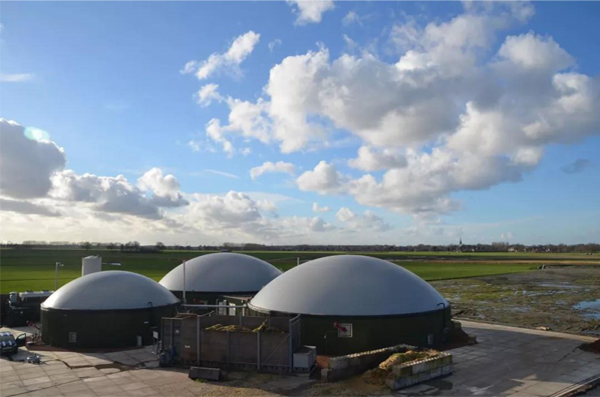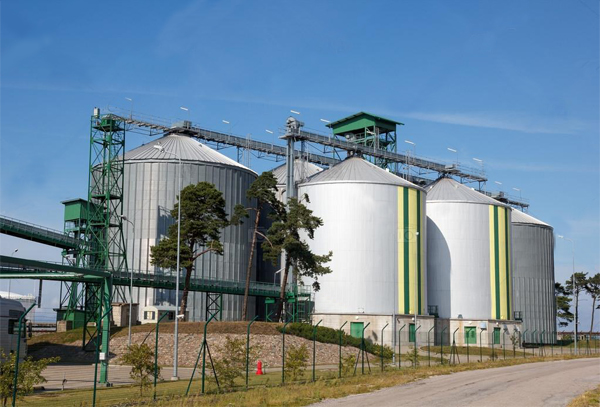 2018-03-14
2018-03-14  2144
2144
Removal of CO2 from bioga

CO2 reduces the energy density of biogas, and the energy value per unit volume of gas can be increased by removing CO2. In addition, removal of CO2 can also improve biogas quality. If the biogas used needs to meet the natural gas standards or be used as automotive fuel, then the CO2 must be removed; if it is used only as a general purpose without special requirements, there is no need to remove CO2.
The physical solvent absorbs CO2 and no new compound is formed. One of the methods uses methanol as an absorbent, and its process feature is that it does not humidify the raw material and its regeneration energy consumption is low. During the regeneration phase, CO2 Flash evaporation out of the physical solvent and the lean solvent is pumped back to the absorption tower.
The physical solvent absorption method is particularly suitable for lean gases with low heavy hydrocarbon content, because the solubility of methane in methanol is only 40% of the solubility of CO2 in methanol, while the solubility of propane in methanol is similar to that of CO2, so a circulatory system is needed. To increase gas recovery.
The physical solvent absorption method can also use anhydrous propylene carbonate and other solvents, but it still does not apply from the current large and medium-sized biogas projects' investment and benefits.
(1)Water washing method
The water wash method utilizes the difference between the solubility of CO2 and H2S in water and methane, and the separation of CO2 and H2S from methane is achieved through a physical absorption process. Biogas usually enters the bottom of the absorption column after being compressed. After the water enters from the top, it absorbs by counter-current flow. In order to improve the solubility of CO2 in water, the water washing process generally adopts higher pressure. The water that has absorbed CO2 and H2S can be recycled for use. It can be depressurized in the absorption column or can be regenerated by air to increase the running cost.
The absorption process requires a large amount of purified industrial water, and the generated wastewater needs to be recycled. The gas after purification needs to be dried and the equipment is more complicated. In addition, when the concentration of H2S in the water is relatively high, it is generally not recommended to use air blowing, because the water will be contaminated with sulfur soon. If water is available, it is not recommended to regenerate the water.
(2)polyethylene glycol washing method
Polyethylene glycol washing, like water washing, is also a physical absorption process. At present, a solvent called Selexol is mostly used, and the main component is dimethylpolyethylene glycol. same as in water, CO2 and H2S have higher solubility in Selexol than methane. The difference is that the solubility of CO2 and H2S in Selexol's solvent is greater than that of water. This reduces the amount of Selexol required, making it more economical and energy-efficient. In addition, water and halogenated hydrocarbons (components in landfill gas) can also be washed with Selexol.
Water vapor or inert gases (purified biogas and natural gas) can be used to blow off elemental sulfur in Selexol, but air is not recommended.
(3) Membrane separation
The basic principle of the gas membrane separation technology is to achieve the purpose of separation based on the different transmission rates of the components in the mixed gas through the membrane driven by the pressure.
Membrane separation There are mainly two methods: one is high-pressure gas separation (both sides of the membrane are gas phase); the other is low-pressure gas-liquid phase absorption separation (molecules that diffuse through the membrane by liquid absorption).
①High pressure gas phase separation
The biogas compressed to 3.6×10 6 Pa was first passed through an activated carbon bed to remove the halogenated hydrocarbons and H 2 S, and then passed into a filter bed and a heater. Membrane is made of cellulose acetate and can be used to separate polar molecules like CO2, water vapor and residual H2S. It has a certain selectivity, that is, it absorbs H2S and CO2 in different regions, However, N2 in methane cannot be separated.
Experience has shown that membranes can last for three years, but after one and a half years of use, membrane permeability is reduced by 30% due to atrophy.
②Gas-liquid phase absorption membrane separation
The essence of the gas-liquid absorption membrane process is that the H2S and CO2 molecules in the biogas are absorbed in the liquid phase through a porous hydrophobic membrane, gas enters under the absorption membrane, H2S and CO2 molecules can diffuse through the membrane, and then It is absorbed by the liquid flowing in the opposite direction. The absorber membrane operates at a standard atmospheric pressure.
At 25~35°C, the concentration of H2S in biogas can be reduced from 2% to less than 250ml/m3, and the liquid phase absorbent can use NaOH solution.
Because the gas separation efficiency is affected by many factors such as membrane material, gas composition, pressure difference, separation factor and temperature, and there is a certain requirement on the cleanliness of raw gas, and the membrane module is expensive, the membrane separation method, Membrane needs to be replaced frequently and the operating cost is high. Therefore, the gas membrane separation method is generally not used alone, and often used in conjunction with solvent absorption, pressure swing adsorption, cryogenic separation, pervaporation and other processes.
The chemical absorption method utilizes the chemical reaction between carbon dioxide and an absorbing liquid to separate carbon dioxide from the exhaust gas. Commonly used are a hot potash alkali method, an organic amine absorption method, a lime aqueous solution absorption method, and an ammonia water method.
The chemical absorption method has the advantages of low cost, simple operation, and good purification effect, but it has high energy consumption and waste liquid treatment problems, and organic amines, which are commonly used as absorbents, are toxic to a certain extent and are not conducive to the reuse of absorbed carbon dioxide.
(1)Hot potash absorption method
The Hot potash absorption method is an effective method for removing carbon dioxide, and is particularly suitable for a low-content or H2S-free gas (biogas). The principle is to use a small amount of organic matter or a large amount of inorganic matter as an activator of the Hot potash absorption method to remove carbon dioxide.
Including carbon dioxide absorption process and solvent regeneration process. Since the two reaction processes are mutually reversible reactions, their absorption efficiency is relatively low. To increase the absorption efficiency, it is necessary to increase the volume of the container, and the CO2 gas after gas-water separation may contain a trace amount of arsenic, which is harmful to the human body. Therefore, it must be cleared. The method of removal is removal by chemical or physical adsorption such as KMnO4, Na2CO3, molecular sieves, and activated carbon.
Through the above analysis, when using the Hot potash absorption method, a filtering procedure is added to remove the harmful substances generated by the absorption method.
The disadvantage of the hot potash absorption method is that the gas is not only humidified and heated, which may cause a considerable waste of heat. In particular, the downstream gas is cooled to separate NGL or LPG, and the hot potash is not very active.
Therefore, when the required CO2 concentration of the product is low, a two-stage absorption method is required to meet the requirement. The hot potash absorption method is most suitable for removing a large amount of CO2 from a high-concentration feed gas. Another benefit is that the cost of the absorbent is relatively low.
(2) Lime aqueous solution absorption method.
The absorption method of lime aqueous solution removes carbon dioxide from biogas, mainly using carbon dioxide and calcium hydroxide solution to produce calcium carbonate precipitation, thereby removing carbon dioxide from methane.
This process is characterized by low cost and relatively low lime costs. Therefore, carbon dioxide is removed, the raw materials are easily obtained, and the cost is low. The purified products were calcium carbonate and water, which did not cause secondary pollution. Therefore, the use of lime aqueous solution to remove carbon dioxide from biogas is a more economical and promising method.
(3) Ammonia absorption
The ammonia method can remove both CO2 and H2S. The main disadvantage is that the desulfurization process is completed under a pressurized device, This increases the running cost.
(4) Organic amine absorption method
The most common solvent is the amine-based solvent, which is used by many compounds to remove acidic gases such as monoethanolamine, diethanolamine, triethanolamine, and diisopropanolamine. They have strong activity and are not limited to CO2 removal. These amine solvents are also suitable for removing other acidic species such as H2S. The current main solvent is methyldiethanolamine, which can be activated with more active diamines if other impurities need to be removed.
Pressure swing adsorption (PSA) is used to separate and refine certain gases in a gas mixture. Adsorption process principle is the use of adsorbents for different gas adsorption, different gas adsorption capacity on the adsorbent, the difference in diffusion rate (such as N2, O2 separation) or gas molecular size to achieve selective adsorption of gas mixture Some of the components for separated from other gases.
At the same time, the adsorption amount of components is influenced by temperature and pressure. When the temperature rises, the adsorption amount decreases, and when the temperature decreases, the adsorption amount increases. When the pressure rises, the adsorption amount increases, and when the pressure decreases, the adsorption amount decreases.
The pressure swing adsorption biogas purification system utilizes a decarbonizing adsorbent to separate gases such as CH4, CO2, and N2 in the biogas to achieve the purpose of purifying CH4. Because certain Very little components (such as sulfides, amides, and hydrocarbon chlorides) in the gas have stronger adsorption than CO2, the gas source requirements are very strict. For example, it is required that the dust concentration of the mixed gas to be separated is less than 5 mg/m3, and the volume fraction of CO2 is high, which is about 25% or more. Therefore, the pressure swing adsorption method has high energy consumption, high cost and the equipment is relatively complex. generally required Select suitable adsorbent, and need more than one adsorber in parallel to ensure the continuity of the entire process, and more in the high pressure or low pressure operation, high equipment requirements,However, it has good wear resistance,Can generally use more than 10 years
Removal of H2O in biogas

The gas-phase biogas in the anaerobic digestion unit is often in a state of water saturation, and the biogas will carry a large amount of moisture to make it have higher humidity. The moisture in biogas has the following adverse effects:
① Hydrogen sulfide in water and biogas generates sulfuric acid, corrodes pipes and equipment;
② Condensation of moisture on diaphragms of check valves, safety valves, flow meters, etc. affects its accuracy;
③ Water can increase the airflow resistance of the pipeline;
④ Water will reduce the calorific value of biogas combustion.
Therefore, dehydration measures should be taken in the transfer system of biogas. According to different uses of biogas, there are three ways to remove the moisture from biogas.
Cold-separation is a process that uses pressure changes to cause temperature changes to condense steam from the gas phase. There are two commonly used process methods:
① throttling expansion cooling dehydration method
This method is generally used for high-pressure fuel gas, separated by throttling or low-temperature condensation, so that part of the water condenses. This method is simple and economical but the water removal effect is not good.
②Pressurized and then cooled
This method can be used for preliminary cooling of high and medium temperature biogas to remove some of the steam. There are three types of cooling methods, namely tubular indirect cooling, direct cooling with packed towers, and Direct - indirect cooling. The above device requires a cooling source and a heat exchanger.
In order to meet the requirements of reasonable amounts of different desulfurizers, high and medium temperature biogas need to consider appropriate cooling and cooling to remove some of the steam in the biogas. In order to avoid the corrosion of the condensate water in the pipeline during the pipeline transportation, or to plug the valve, the method of installing the water trap at the lowest point of the pipeline is often adopted, and the vapor condensed in the biogas is accumulated and periodically eliminated. It reduces the moisture content in the biogas.
The liquid solvent absorption method allows the biogas to pass through a highly water-absorbent solution to separate the water. Dehydrating agents belonging to this class include calcium chloride, lithium oxide and glycols.
Calcium chloride has a low price and low loss, but it emulsifies when it meets with oils. The solution can produce electrolytic corrosion; precipitation occurs when it contacts with H2S. For this reason, this method has been gradually weed out.
Lithium oxide solution has strong water-absorbing ability, less corrosiveness, and is not easy to decompose with water. It is obviously better than calcium chloride, but it is expensive.
Glycol dehydrating agents have much better performance than other types of dehydrating agents. Diethylene glycol and triethylene glycol have strong water absorption properties. Therefore, triethylene glycol is most commonly used, but the main disadvantage of this method is that the initial investment is high.
The solid physical absorption method is classified into chemical adsorption (cannot be regenerated after dehydration) and physical adsorption (regeneration after dehydration) according to the properties of surface forces. Can be used for biogas dehydration of silica gel, magnesium oxide, activated alumina, molecular sieves and composite fixed desiccant, composite fixed desiccant combines the advantages of a variety of desiccants.
Compared with solution dehydration, the solid adsorption and dehydration performance far exceeds the former, and fuel gas with extremely low dew point can be obtained; it is insensitive to changes in fuel gas temperature, pressure, and flow rate; the equipment is simple and easy to operate; corrosion and blistering rarely occur.
Two sets of devices are usually used, and when one device is working, the other device can be regenerated. The desiccant can be regenerated in two ways. One is to regenerate the desiccant with a part of the high-pressure drying gas (3%~8%). This part of the gas can be returned to the compressor inlet again; the other is under normal pressure. Using air and vacuum pumps to regenerate the desiccant, this method will mix air into the biogas and will not generally be used. In addition, adsorption and regeneration of the desiccant in the physical adsorption method are alternated, and the continuous operation is affected.
 Current location:Home - News Center - Industry Update
Current location:Home - News Center - Industry Update


 Sales hot-line:0816-3736605
Sales hot-line:0816-3736605 E-mail:jysongwei@126.com
E-mail:jysongwei@126.com Address:No. 772, Laojun Road, Jiangyou, Sichuan
Address:No. 772, Laojun Road, Jiangyou, Sichuan

 QQ
QQ Tel
Tel Message
Message Share
Share Top
Top